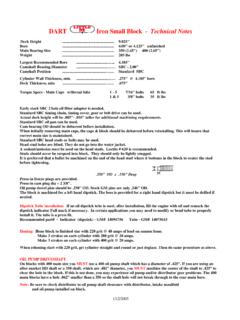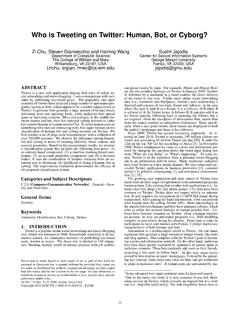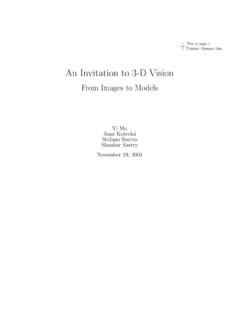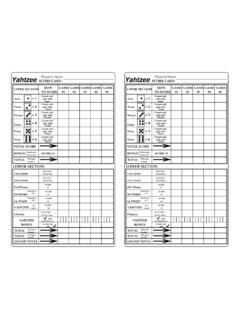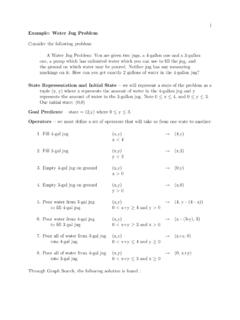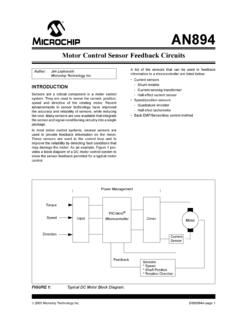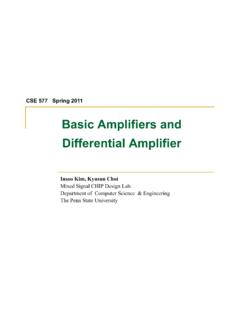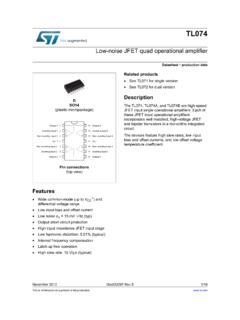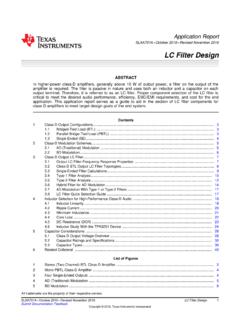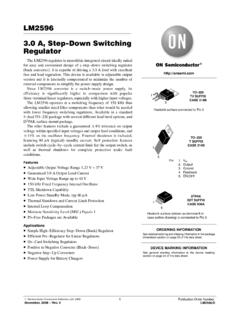Transcription of Differential Opamp Simulation
1 Department of Electrical and Computer Engineering Vishal Saxena-1-Loop Stability AnalysisDifferential Opamp SimulationVishal Saxena & Zhu KehanBoise State University Vishal Saxena-2-Spectre STB Analysis The STB analysis linearizes the circuit about the DC operating point and computes the loop-gain, gain and phase margins (if the sweep variable is frequency ), for a feedback loop or a gain device [1]. Refer to the Spectre Simulation Refrence [1] and [2] for details. Uses return ratio analysis method to calculate loop-gain and phase margin ([3, 4]). Vishal Saxena-3-Example Single-ended Opamp Schematic Vishal Saxena-4-STB Analysis Test Bench Pay attention to the iprobecomponent (from analogLib) Acts as a short for DC, but breaks the loop in stb analysis Place the probe at a point where it completely breaks (all) the loops. Vishal Saxena-5-DC Annotation Annotating the node voltages and DC operating points of the devices helps debug the design Check device gds to see if its in triode or saturation regions Vishal Saxena-6- Simulation Setup Always have dc analysis on for debugging purpose Vishal Saxena-7-Bode Plot Setup Results Direct Plot Main Form Vishal Saxena-8-Loop Response Bode Plots Here, fun= MHz, PM= Try to use the stb analysis while the circuit is in the desired feedback configuration Break the loop with realistic DC operating points Vishal Saxena-9-Transient Step Response Test Bench Transient step-response verifies the closed-loop stability Use small as wells as large steps for characterization iprobe acts as a short (can remove it from transient sims) Vishal Saxena-10-Small Step Response Observe the ringing (PM was 41 )
2 Compensate more! Correlate small-step response with the open-loop frequency response for your understanding. Vishal Saxena-11-Large Step Response Use large steps for large signal response Not captured by the small-signal analysis Note the slewing in the output here Vishal Saxena-12-Fully- Differential Opamp SimulationContinuous-time CMFB Vishal Saxena-13-CMDM Probe Located in library: AnalogLib cmdmprobe Variable CMDM = -1 measures Differential mode response +1 measures common mode response In IC615, diffstbprobe is available which handles unbalanced Differential circuits better than the cmdmprobe. More information on the Differential probes and the STB analysisalgorithm can be found in [4]. Vishal Saxena-14-Fully Differential Circuit Analysis Use CMDM probe for Differential analysis [1, 3] Placement of the CMDM probe should break the Differential as well the common-mode loops.
3 Vishal Saxena-15-Fully Differential Circuit Analysis Method1 For internal loops, isolate those loops individually and perform STB analysis Ensure overall DC feedback for accurate biasing and that all loops are compensated CMDM1measures only the first-stage CM response CMDM2measures overall DM response and second-stage CM response Vishal Saxena-16-Fully Differential Circuit Analysis Method2 cmdmprobes placed outside DM loop, only in CMFB loops CMDM1measures only the first-stage CM response CMDM2measures only the second-stage CM response But need another CMDM probe to measure DM loop stability Results match with iprobe results very well. Vishal Saxena-17- Vishal Saxena and Venkatesh Acharya17 Fully Differential Opamp Schematic Two-stage fully Differential Opamp Class AB output stage for large voltage swing With individual CMFB. 1st stage CMFB compensated Vishal Saxena-18- Vishal Saxena and Venkatesh Acharya18 STB Analysis Using Method 1 Be noted that the nulling resistors should be connected before the inputs of cmdmprobe in the 1stCMFB loop, or it will generate incorrect results.
4 Vishal Saxena-19- Vishal Saxena and Venkatesh Acharya19 STB Analysis Using Method 2 Need one extra cmdmprobe to measure DM loop comparing to method 1. Vishal Saxena-20-DM Loop Bode Plots M1&M2 Differential Mode loop gain and phase margin plots Same results obtained by using Method 1 and Method 2 Vishal Saxena-21-Method 11stStage CMFB Loop Bode PlotsMethod 2 Vishal Saxena-22-2ndStage CMFB Loop Bode PlotsMethod 1 Method 2 Vishal Saxena-23- Simulation Setup Use previous oppt(operating point) in the stb analysis Vishal Saxena-24-Bode Plot Setup Results Direct Plot Main Form Vishal Saxena-25-DM Transient Unity- gain inverting amplifier transient response with a 200mV Differential step (rise/fall time= , pulse with=100ns) Vishal Saxena-26-CM Transient Unity- gain inverting amplifier transient response with a 100mV common mode step (rise/fall time= , pulse with=100ns)
5 Vishal Saxena-27-Fully- Differential Opamp SimulationSwitched-capacitor CMFB Vishal Saxena-28-Switched Capacitor CMFB Simulation 2-stage Class AB output Opamp Individual SC-CMFB Vishal Saxena-29- Vishal Saxena and Venkatesh Acharya29 PSTB Analysis Using Method 1 PSTB analysis is essential for sampled circuit Vishal Saxena-30- Simulation Setup---PSS We can only set the number of harmonics to 0 by choosing Shooting method tstab parameter can be obtained by tran analysis first Vishal Saxena-31-PSS Accuracy suggestions Go to Simulation Options Analog Main in the ADE window to setup tolerance options accordingly. If the frequency of periodic small signal analyses followed by PSS is high ( 1G), the maxacfreqparameter (options accuracy) of the PSS can be used to specify the highest frequency , otherwise, the frequency analysis in PAC maybe truncated.
6 Vishal Saxena-32-PSS Time Plot Results Direct Plot Main Form X-axis scale range is 1/sampling clock frequency Vishal Saxena-33-PSTB Setup PSTB is always followed by PSS Vishal Saxena-34-PSTB Plot Results Direct Plot Main Form Vishal Saxena-35-DM Loop Bode PlotsResistive feedbackCapacitive feedback Vishal Saxena-36-1stStage CMFB Loop Bode PlotsResistive feedbackCapacitive feedback Vishal Saxena-37-2ndStage CMFB Loop Bode PlotsResistive feedbackCapacitive feedback Vishal Saxena-38- Vishal Saxena and Venkatesh Acharya38 Summary of pstb analysis Vishal Saxena-39-Resistive Feedback DM Transient Unity- gain inverting amplifier transient response with a 200mV Differential step (rise/fall time= , pulse with=200ns) Vishal Saxena-40-Resistive Feedback CM Transient Unity- gain inverting amplifier transient response with a 100mV common mode step (rise/fall time= , pulse with=200ns) Vishal Saxena-41-Sample-Hold Configuration Ideal switches with on resistance of 1k Vishal Saxena-42-Sample-Hold Transient Response DM and CM outputs waveforms when fin=1/4 MHz, fs=5 MHz Vishal Saxena-43-Sample-Hold Transient Response DM and CM outputs waveforms when fin=11/4 MHz, fs=5 MHz Vishal Saxena-44-References[1] Spectre User Simulation Guide, pages 160-165[2] M.
7 Tian, V. Viswanathan, J. Hangtan, K. Kundert, Striving for Small-Signal Stability: Loop-based and Device-based Algorithms for Stability Analysis of Linear Analog Circuits in the frequency Domain, Circuits and Devices, Jan 2001.[3] P. R. Gray, P. J. Hurst, S. H. Lewis, R. G. Meyer, Analog and Design of Analog Integrated Circuits, 4th Ed., Wiley, 2010.[4] F. Wiedmann, Loop gain Simulation , Online.

